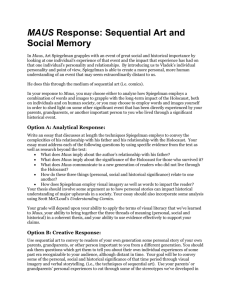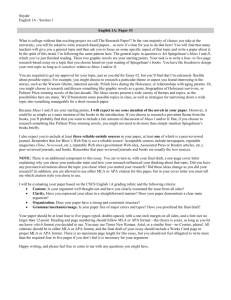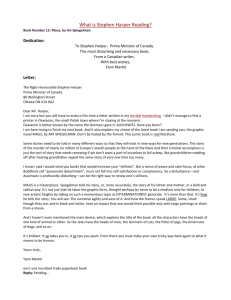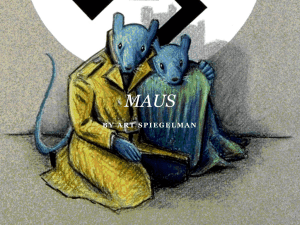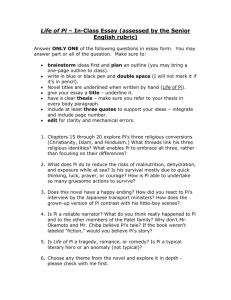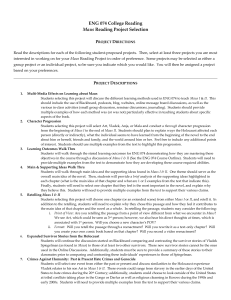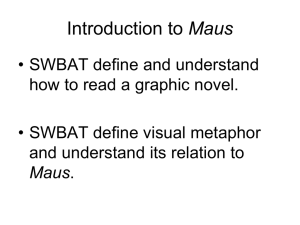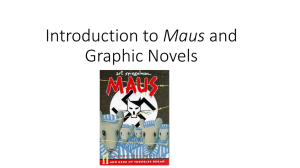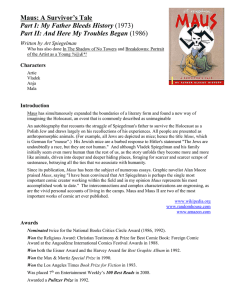J. George 05/14/12 Maus Analytical Essay (two part assignment
advertisement
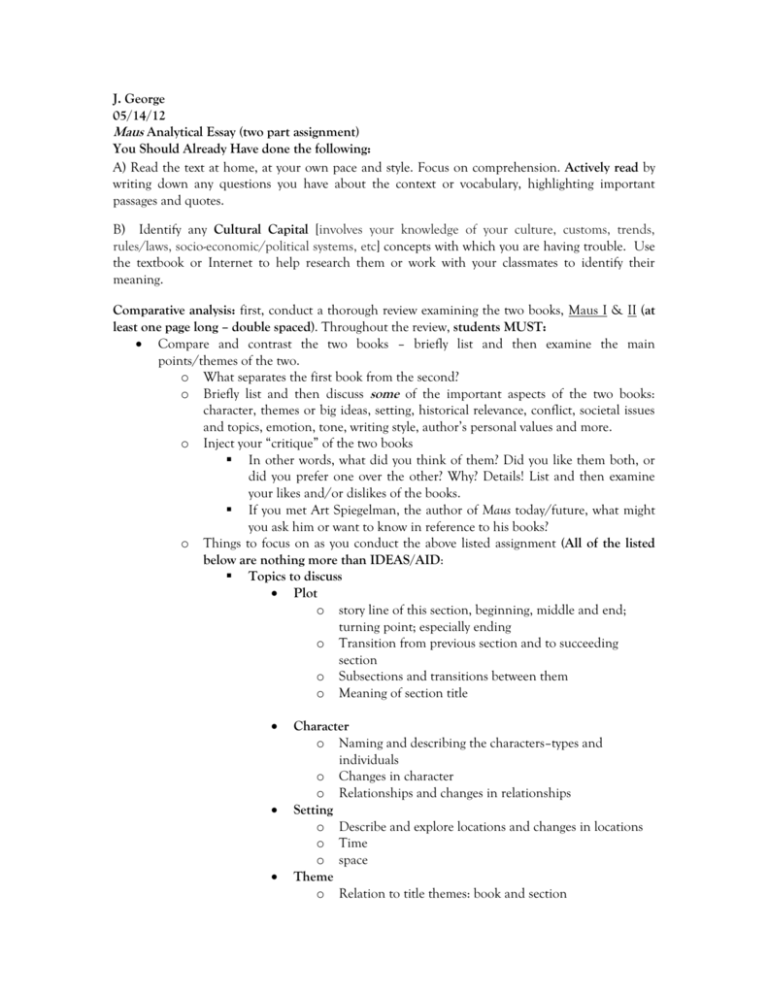
J. George 05/14/12 Maus Analytical Essay (two part assignment) You Should Already Have done the following: A) Read the text at home, at your own pace and style. Focus on comprehension. Actively read by writing down any questions you have about the context or vocabulary, highlighting important passages and quotes. B) Identify any Cultural Capital [involves your knowledge of your culture, customs, trends, rules/laws, socio-economic/political systems, etc] concepts with which you are having trouble. Use the textbook or Internet to help research them or work with your classmates to identify their meaning. Comparative analysis: first, conduct a thorough review examining the two books, Maus I & II (at least one page long – double spaced). Throughout the review, students MUST: Compare and contrast the two books – briefly list and then examine the main points/themes of the two. o What separates the first book from the second? o Briefly list and then discuss some of the important aspects of the two books: character, themes or big ideas, setting, historical relevance, conflict, societal issues and topics, emotion, tone, writing style, author’s personal values and more. o Inject your “critique” of the two books In other words, what did you think of them? Did you like them both, or did you prefer one over the other? Why? Details! List and then examine your likes and/or dislikes of the books. If you met Art Spiegelman, the author of Maus today/future, what might you ask him or want to know in reference to his books? o Things to focus on as you conduct the above listed assignment (All of the listed below are nothing more than IDEAS/AID: Topics to discuss Plot o story line of this section, beginning, middle and end; turning point; especially ending o Transition from previous section and to succeeding section o Subsections and transitions between them o Meaning of section title Character o Naming and describing the characters–types and individuals o Changes in character o Relationships and changes in relationships Setting o Describe and explore locations and changes in locations o Time o space Theme o Relation to title themes: book and section o Personal and social issues o Consistent or inconsistent "message" Striking language--verbal and pictorial o Pick one frame and one two page layout that is particularly interesting--verbally and graphically; describe and say why o Find one place that makes you sad and one that makes you laugh Part Two: Please choose one of the following topics for your formal analysis of Art Spiegelman’s Maus I and II. You are welcomed to use these topics as points of reference and departure, to mix and match them, or to come up with a topic of your own (but if you do this, please run it by me first). What’s most important is that you can write about your topic with passion and precision. No matter what your choice, you must consider the organic mutuality of form and content in your essay; in other words, your analysis will inevitably consider how the graphic form of Maus works in service of the novel’s ideas and issues. The 2-3 page essay should be turned in as a hard copy. For this essay, you’ll need a thesis that offers a sharp angle of interpretation and topic sentences that deepen and develop the thesis idea. You’ll also need precise textual support [hint: quotes] (where are you citations?). Please see your notes, handout and/or the MLA website for assistance to refresh your memory about writing literary analysis. Remember to cite your sources following MLA protocol (in-text citations and “Work Cited”). Choose anyone of the following TOPICS, or you are free to create one on your own – just run it by me prior to starting things off. • Analyze the dialogic narrative structure of the novel. How do the interplay of the contemporary conversations and the history of the Holocaust add depth and dimension to the story? • Analyze the novel as a metafiction (look it up). How does Spiegelman’s choice to foreground his role as writer contribute to the meaning of the novel? • Analyze the relationship between Art Spiegelman and his father, Vladek. How do the tensions in their contemporary father-son dynamic complicate the enterprise of recording Vladek’s historical experience of the Holocaust? • Analyze Art Spiegelman’s relationship with his mother, Anja. How do the research for and the writing of this novel factor in to his relationship with her? • In Maus II Vladek notes about the gas chambers: “For this I was an eyewitness” (69). How does this very notion authenticate his “Survivor’s Tale,” especially given the subtitle of Maus I— “My Father Bleeds History”? • What does it mean to be “a survivor”? How does “survivor’s guilt” factor into the characters of Vladek and Art Spiegelman as Jewish father and son? • How does the maxim “The personal is political” (and vice versa—“the political is personal”) hold true in this story? • Analyze the role of mental illness in the novel. • Select any visual motif (Stars of David, swastikas, the use of mice and cats and pigs to represent different racial groups, for instance) and analyze the way this visual representation contributes to the aesthetic, intellectual, emotional, and thematic texture of the novel. • Offer a close reading of the cover art and/or a selection of the chapter titles and companion illustrations, and analyze the ways they contribute to the mood and meaning of the relevant chapters and to the novel as a whole. • Compare and contrast the graphic style of Maus I and II with that of “Prisoner of the Hell Planet” (100-103 Maus I), the interpolated section depicting Art Spiegelman’s response to his mother’s suicide. How do the different styles contribute to the moods and meanings of the respective comics? In your paper you will use quotes from the scene, page layout, and the pictures to analyze how the author characterizes your chosen character. How should my paper be structured? This is an analytical paper. Therefore, your paper should have a clear introduction introducing your chosen character and scene. There should also be a clearly recognizable thesis statement. The paper should be organized into body paragraphs and end with a conclusion that ties the entire paper together. How long should this paper be? 2-3 pages, double spaced, Times New Roman Font, standard margins Do I need a works cited page and parenthetical citations? Yes you do. Since this is an analysis essay, you will be using quotes from the text to support your ideas. Therefore, a MLA works cited page, and MLA parenthetical documentation is required. When is this paper due? All papers are due on Friday, June 1st 2012. So, what exactly should be turned in? The following should be turned in the listed order: -Rubric - Final Paper (with page number of scene analyzed in heading) Be sure to underline your thesis statement -Works Cited Page -Rough Draft/Pre-Writing Page of Helpful Tips/Terms/Ideas How do you read a graphic novel? Read top left hand corner frame to right and down left to right. Read the images as well as the words. Pay attention to the way the images are positioned within the frames. Notice the different way words exist in the frames. Either spoken: “speech bubbles” or “narration” (information given to the reader, not spoken out loud by characters). Terms to know: Frames: the boxes that have the images, they are read left, right, top, bottom (usually) Close-up: images are bigger, implying a “close-up” camera angle Tight focus: one small aspect of the image is emphasized with a very close, tight shot. Long-shot: images are farther away, implying the viewer sees them from a farther distance. Worm’s eye view: images are seen from a “ground” viewpoint looking up. Bird’s eye view (ariel shot) images are seen from an “above” vantage looking down. Characterization is the name for the techniques a writer uses to reveal the personality of characters to the reader. Characterization is achieved in a number of different ways: Words: Comments by the narrator, dialogue by others about the character, as well as the character’s own words; what is said, as well as how it is said – dialect, slang, tone -are important. Thoughts: What’s going on in the character’s mind, the character’s motives and choices Appearance: The character’s physical characteristics and clothing Actions: What the character does Interactions: How the character relates to others and others relation to character Names: Often symbolic of a major character trait or role Chosen Setting: The items, furnishings, etc. with which the character chooses to surround himself/herself Change/Development: The occurrence of and direction of change or development that a character undergoes inwardly. Possible Characters and Scenes: Vladek: pgs 5-6, 43-44, 45-46, 51-52, 57-58, 63-64, 67-68, 100-103 Artie: pgs 5-6, 67-68, 68-69, 96-97, 100-103 Anja: pgs 17-18, 31-32, 100-103 Mala: pgs 92-93
